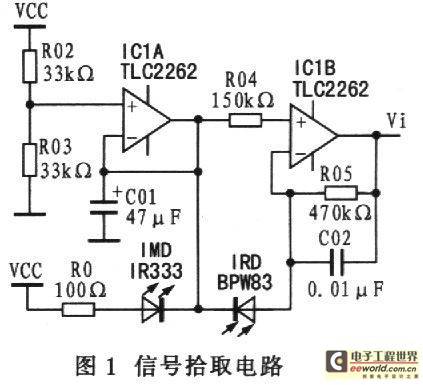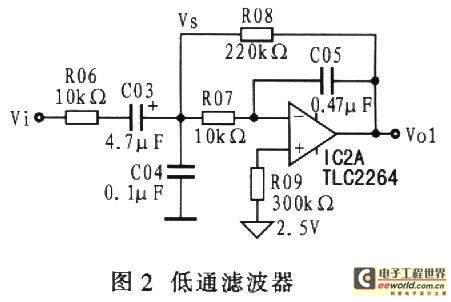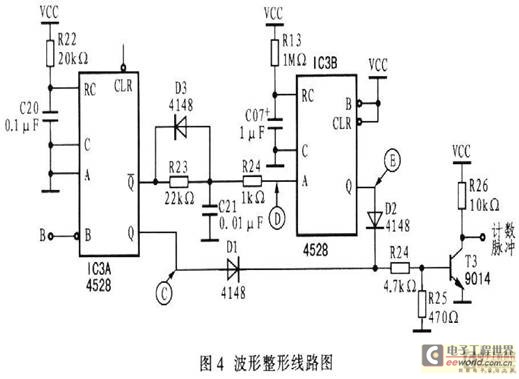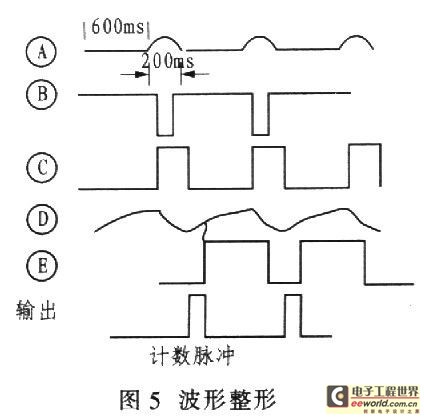1 Introduction
Pulse measurement is a measurement to detect whether there is a pulse. When there is a pulse, the light is blocked. When there is no pulse, the light is highly transparent. The sensors used are infrared receiving diodes and infrared emitting diodes. There are two ways to measure pulse for sports measurement: finger pulse and ear pulse. These two measurement methods have their own advantages and disadvantages. Finger pulse measurement is more convenient and simple, but because there are more sweat glands on the fingers, the finger clips are used all year round, and pollution may reduce the measurement sensitivity; ear pulse measurement is cleaner, the sensor is used in a less polluted environment, and it is easy to maintain. However, because the ear pulse is weak, especially when the seasons change, the measured signal is significantly affected by the ambient temperature, resulting in inaccurate measurement results.
2 Pulse signal pickup
The pulse signal pickup circuit is shown in Figure 1. IClA is connected as a unit gain buffer to generate a reference voltage of 2.5V. 
The infrared receiving diode can generate electrical energy under the irradiation of infrared light. A single diode can generate a voltage of 0.4 V and a current of 0.5 mA. The operating wavelength of the BPW83 infrared receiving diode and the IR333 infrared emitting diode is 940 nm. In the finger clip, the infrared receiving diode and the infrared emitting diode are placed relative to each other to obtain the best directional characteristics. The larger the current in the infrared emitting diode, the smaller the emission angle, and the greater the emission intensity. In Figure 1, RO is selected as 100 Ω based on the infrared receiving diode's sensitivity to infrared light. If R0 is too large, the current passing through the infrared emitting diode is too small, and the BPW83 infrared receiving diode cannot distinguish between the signals with and without pulse. On the contrary, if R0 is too small, the current passing through is too large, and the infrared receiving diode cannot accurately distinguish between the signals with and without pulse. When the infrared light emitted by the infrared emitting diode directly irradiates the infrared receiving diode, the potential of the inverting input terminal of IC1B is greater than the potential of the non-inverting input terminal, and Vi is "O". When the finger is in the measuring position, two situations will occur: one is the pulseless period. Although the finger blocks the infrared light emitted by the infrared emitting diode, due to the dark current in the infrared receiving diode, there is still a dark current of lμA, which will cause the Vi potential to be slightly lower than 2.5 V. The second is the pulse period. When there is a beating pulse, the blood vessels make the finger less transparent, the dark current in the infrared receiving diode decreases, and the Vi potential rises.
From this point of view, the so-called pulse signal is actually obtained by the infrared receiving diode, the slight change of the dark current when there is a pulse and no pulse, and then amplified by IClB. The picked-up signal is a voltage signal of about 2μV.
3 Signal amplification
The low-pass amplifier is designed based on the maximum number of beats of the human pulse after exercise of 240 times/minute. It is composed of IC2A and C04, as shown in Figure 2. The turning frequency is determined by R07, C04, R08 and C05, and the amplification factor is determined by the ratio of R08 and R06. 
According to the transfer function of the second-order low-pass filter, it can be obtained that 
the low-frequency characteristics are satisfactory considering that the human pulse is up to 4 Hz.
It should be noted that the above analysis is made under the condition of ignoring C03. If C03 is considered, then:
It can be seen that C03 does not affect the analysis of frequency characteristics, and its role is only to isolate the DC.
The secondary amplifier and comparator are shown in Figure 3. Rpll is used to adjust the amplification factor of the system, and C06 is used to prevent the amplifier from self-excitation. With secondary amplification, the zero drift is not very obvious, at around 0.1 V. Therefore, the threshold voltage of the comparator is designed to be 0.25 V to ensure that the interference signal is filtered out. The advantage of using a comparator is that it can effectively overcome the influence caused by zero drift and improve the accuracy of measurement. [page]
4 Waveform shaping
The waveform shaping circuit is shown in Figure 4. IC3A is a CD4528 monostable multivibrator with an effective pulse width of 0.05 s. Its width is determined by R22 and C20. IC3B also forms a monostable multivibrator with a pulse width of 240ms. D2, D1 and T3 form an NOR gate. Only when both C and E are low, the output of the signal amplifier is high. The purpose of designing this circuit is to output a narrow pulse at the output end, and any signal will not interfere with the output within the time determined by R13 and C07. The length of the charging time of R23 and C21 determines the width of the counting pulse, which is generally not expected to be too wide. The waveform shaping timing is shown in Figure 5.

5 Conclusion
When this amplifier is used in a cluster pulse measurement instrument, it is important to pay attention to the mutual influence between different signal channels. It is recommended to separate the power supplies of each amplifier. In addition, the measurement channel requires a switch circuit. When the finger clip is suspended, this switch circuit turns off the monostable circuit, cuts off the signal path, and prevents random counting.
Several years of production practice have proved that the amplification processing circuit is stable and reliable. The following are some of the experiences I have gained in the design.

It is better to use two-stage amplification than three-stage amplification. The zero drift of some three-stage amplification circuit boards is large enough to reach full amplitude, making the measurement inaccurate. The amplification factor of each single-stage amplifier should not be greater than 30 to avoid self-oscillation. The
high-frequency turning frequency of this signal amplifier is determined by C05, C04, R07, R08 and R06. C05 and C04 are usually polypropylene capacitors or polycarbonate capacitors, and R07, R08 and R06 are usually metal film five-color ring resistors.
IClA, R02 and R03 form a voltage follower with a design value of 2.5 V. The accuracy is determined by R02 and R03. It is best to use metal film five-color ring resistors.
The leakage of the DC blocking capacitor C03 should be small, and it is better to use a tantalum electrolytic capacitor.
IClA and IC1B should use operational amplifiers with small bias current and small input offset voltage. Considering the cost performance, the author used TLC2264 and TLC2262.
Previous article:Analysis of the test principle of TDA7294 high-power integrated amplifier circuit
Next article:Application of Phase-Locked Loop in Microcomputer Protection
- Popular Resources
- Popular amplifiers
- Keysight Technologies Helps Samsung Electronics Successfully Validate FiRa® 2.0 Safe Distance Measurement Test Case
- From probes to power supplies, Tektronix is leading the way in comprehensive innovation in power electronics testing
- Seizing the Opportunities in the Chinese Application Market: NI's Challenges and Answers
- Tektronix Launches Breakthrough Power Measurement Tools to Accelerate Innovation as Global Electrification Accelerates
- Not all oscilloscopes are created equal: Why ADCs and low noise floor matter
- Enable TekHSI high-speed interface function to accelerate the remote transmission of waveform data
- How to measure the quality of soft start thyristor
- How to use a multimeter to judge whether a soft starter is good or bad
- What are the advantages and disadvantages of non-contact temperature sensors?
- LED chemical incompatibility test to see which chemicals LEDs can be used with
- Application of ARM9 hardware coprocessor on WinCE embedded motherboard
- What are the key points for selecting rotor flowmeter?
- LM317 high power charger circuit
- A brief analysis of Embest's application and development of embedded medical devices
- Single-phase RC protection circuit
- stm32 PVD programmable voltage monitor
- Introduction and measurement of edge trigger and level trigger of 51 single chip microcomputer
- Improved design of Linux system software shell protection technology
- What to do if the ABB robot protection device stops
- Allegro MicroSystems Introduces Advanced Magnetic and Inductive Position Sensing Solutions at Electronica 2024
- Car key in the left hand, liveness detection radar in the right hand, UWB is imperative for cars!
- After a decade of rapid development, domestic CIS has entered the market
- Aegis Dagger Battery + Thor EM-i Super Hybrid, Geely New Energy has thrown out two "king bombs"
- A brief discussion on functional safety - fault, error, and failure
- In the smart car 2.0 cycle, these core industry chains are facing major opportunities!
- The United States and Japan are developing new batteries. CATL faces challenges? How should China's new energy battery industry respond?
- Murata launches high-precision 6-axis inertial sensor for automobiles
- Ford patents pre-charge alarm to help save costs and respond to emergencies
- New real-time microcontroller system from Texas Instruments enables smarter processing in automotive and industrial applications
- Open source development board CANPico
- Melexis High Reliability Programmable Hall Switch, you are invited to watch the live broadcast at 10:00 on May 21st
- Newbie question, please help! I just learned analog electronics and built a simple circuit using Multisim
- 【Zero Knowledge ESP8266】Tutorial: Mobile APP Control RGB LED
- The application of CAN bus data in automobile digital technology is the starting point
- TI AM335 Embedded Hardware Design Reference Guide OK335xD
- Infineon Position2Go Development Kit Review @2. Official Tools
- [Atria AT32WB415 Review] 2. Firmware burning (taking AT-Link burning as an example)
- MOS tube anti-reverse connection
- Why do DSPs with large on-chip RAM have high efficiency?

 5962-9455301MCA
5962-9455301MCA















 京公网安备 11010802033920号
京公网安备 11010802033920号